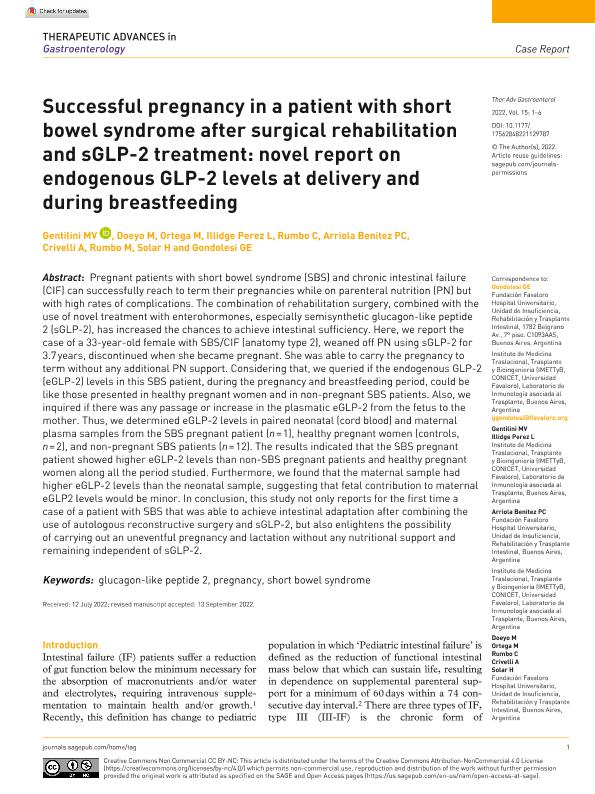Artículo
Successful pregnancy in a patient with short bowel syndrome after surgical rehabilitation and sGLP-2 treatment: novel report on endogenous GLP-2 levels at delivery and during breastfeeding
Gentilini, Maria Virginia ; Doeyo, M.; Ortega, M.; Illidge Perez, L.; Rumbo, C.; Arriola Benitez, Paula Constanza
; Doeyo, M.; Ortega, M.; Illidge Perez, L.; Rumbo, C.; Arriola Benitez, Paula Constanza ; Crivelli, A.; Rumbo, Martín
; Crivelli, A.; Rumbo, Martín ; Solar, H.; Gondolesi, Gabriel Eduardo
; Solar, H.; Gondolesi, Gabriel Eduardo
 ; Doeyo, M.; Ortega, M.; Illidge Perez, L.; Rumbo, C.; Arriola Benitez, Paula Constanza
; Doeyo, M.; Ortega, M.; Illidge Perez, L.; Rumbo, C.; Arriola Benitez, Paula Constanza ; Crivelli, A.; Rumbo, Martín
; Crivelli, A.; Rumbo, Martín ; Solar, H.; Gondolesi, Gabriel Eduardo
; Solar, H.; Gondolesi, Gabriel Eduardo
Fecha de publicación:
11/2022
Editorial:
SAGE Publications
Revista:
Therapeutic Advances in Gastroenterology
ISSN:
1756-2848
Idioma:
Inglés
Tipo de recurso:
Artículo publicado
Clasificación temática:
Resumen
Pregnant patients with short bowel syndrome (SBS) and chronic intestinal failure (CIF) can successfully reach to term their pregnancies while on parenteral nutrition (PN) but with high rates of complications. The combination of rehabilitation surgery, combined with the use of novel treatment with enterohormones, especially semisynthetic glucagon-like peptide 2 (sGLP-2), has increased the chances to achieve intestinal sufficiency. Here, we report the case of a 33-year-old female with SBS/CIF (anatomy type 2), weaned off PN using sGLP-2 for 3.7 years, discontinued when she became pregnant. She was able to carry the pregnancy to term without any additional PN support. Considering that, we queried if the endogenous GLP-2 (eGLP-2) levels in this SBS patient, during the pregnancy and breastfeeding period, could be like those presented in healthy pregnant women and in non-pregnant SBS patients. Also, we inquired if there was any passage or increase in the plasmatic eGLP-2 from the fetus to the mother. Thus, we determined eGLP-2 levels in paired neonatal (cord blood) and maternal plasma samples from the SBS pregnant patient (n = 1), healthy pregnant women (controls, n = 2), and non-pregnant SBS patients (n = 12). The results indicated that the SBS pregnant patient showed higher eGLP-2 levels than non-SBS pregnant patients and healthy pregnant women along all the period studied. Furthermore, we found that the maternal sample had higher eGLP-2 levels than the neonatal sample, suggesting that fetal contribution to maternal eGLP2 levels would be minor. In conclusion, this study not only reports for the first time a case of a patient with SBS that was able to achieve intestinal adaptation after combining the use of autologous reconstructive surgery and sGLP-2, but also enlightens the possibility of carrying out an uneventful pregnancy and lactation without any nutritional support and remaining independent of sGLP-2.
Palabras clave:
GLUCAGON-LIKE PEPTIDE 2
,
PREGNANCY
,
SHORT BOWEL SYNDROME
Archivos asociados
Licencia
Identificadores
Colecciones
Articulos (IMETTYB)
Articulos de INSTITUTO DE MEDICINA TRASLACIONAL, TRASPLANTE Y BIOINGENIERIA
Articulos de INSTITUTO DE MEDICINA TRASLACIONAL, TRASPLANTE Y BIOINGENIERIA
Articulos(IIFP)
Articulos de INST. DE ESTUDIOS INMUNOLOGICOS Y FISIOPATOLOGICOS
Articulos de INST. DE ESTUDIOS INMUNOLOGICOS Y FISIOPATOLOGICOS
Articulos(IIMT)
Articulos de INSTITUTO DE INVESTIGACIONES EN MEDICINA TRASLACIONAL
Articulos de INSTITUTO DE INVESTIGACIONES EN MEDICINA TRASLACIONAL
Citación
Gentilini, Maria Virginia; Doeyo, M.; Ortega, M.; Illidge Perez, L.; Rumbo, C.; et al.; Successful pregnancy in a patient with short bowel syndrome after surgical rehabilitation and sGLP-2 treatment: novel report on endogenous GLP-2 levels at delivery and during breastfeeding; SAGE Publications; Therapeutic Advances in Gastroenterology; 15; 11-2022; 1-6
Compartir
Altmétricas



